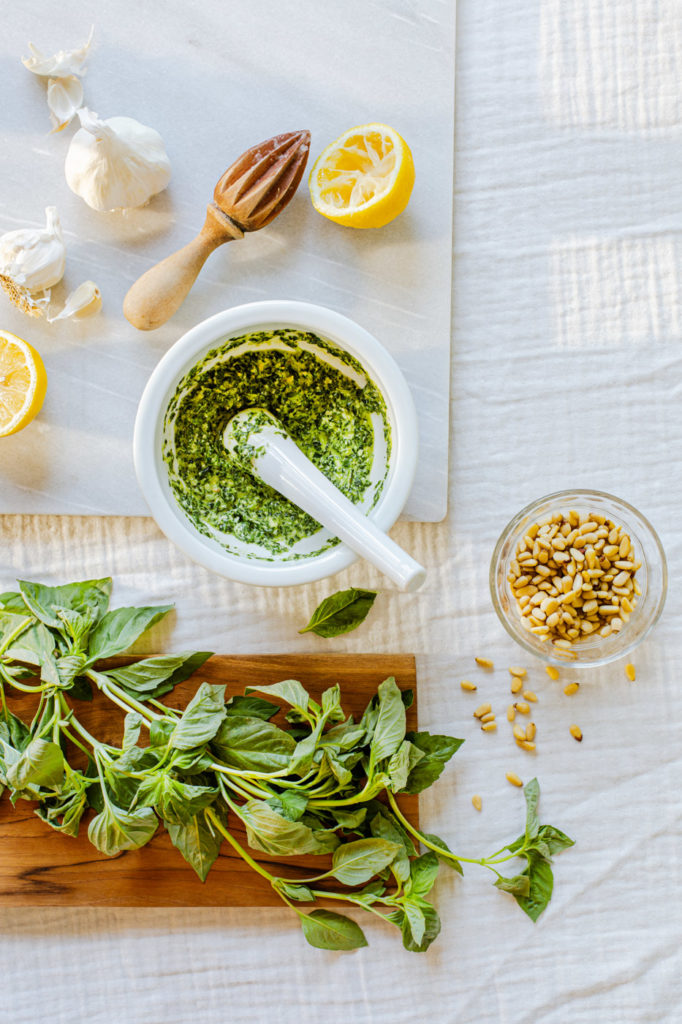
Pesto for the People
Growing up, my grandmother’s kitchen was always redolent of basil. Not only did my grandfather’s garden overflow with it, but she typically kept a plant on the windowsill in the kitchen above the sink. Washing dishes was often my (chosen) duty. I would stand scrubbing and sniffing, taking in the heady herb’s aroma and without really knowing it, filing it into a mental Rolodex of sense memory. Years later, feeling homesick and disconnected from my family while in quarantine, I purchased a basil plant of my own on a whim.
Given my perpetually brown thumb, I couldn’t believe how I was able to get this little guy to thrive. A sprinkle of water and sunlight, and I suddenly found myself with an abundance of beautifully fragrant, familiarly verdant leaves. Overnight, I became the Bubba Gump of basil—tucking leaves in nearly everything I ate (and drank, for that matter).
Perhaps more than anything though, I was excited about making lots of pesto. Classic Pesto Genovese originated in and is a staple of the Italian region of Liguria. When done right, with the brightness of lemon and loads of green herb, it’s like swallowing a Mediterannean summer with a single bite. But one of the things I love so much about pesto is its versatility and adaptability. I prefer recipes that allow what I like to call—excuse the language—“fuck-with-ability.” Meaning, well, exactly as it sounds.
I’m notoriously underprepared when I step into the kitchen; this formula allows me to just be me, and for cooks with a little foresight, there’s real room for creativity too. Different herbs, oils, nut and cheese combinations can be tailored not only for particular finished dishes, but based on what’s available, in-season, and on hand. Mix and match herbs, leafy greens like spinach or kale—you can even use “discard” items like carrot or beet tops or even fennel fronds. Try it with orange or grapefruit. Use a chili- or fruit-infused olive oil. Change up the nut selection, or use a blend. Swap the Italian cheese for something from your favorite local producer. It’s the choose-your-own adventure of culinary blueprints.
I love that pesto is so rooted in Italian culture, but can be adapted to just about any cuisine imaginable. Try cilantro-cotija for a Mexican spin. Coriander leaves with lime and cashew create a Vietnamese vibe. Feta and dill conjure a Greek flavor profile.
And just as versatile are its uses. Pesto Genovese is traditionally served with trofie or other pasta shapes. But pesto and its many variations will work just as well tossed into a cold summer macaroni salad, or be paired with chicken or shellfish for a protein-focused dish. It can be worked into a dressing for salad or vegetables or spread on toast for breakfast (bonus points for adding a fried egg). Hell, I love pesto on burgers in the summertime, and in wilder moments, a minty version has made its way into a dessert or two.
Pesto is also forgiving for budgetary purposes. Pine nuts may be quite pricey; peanuts are much more affordable. Particularly if you’re willing to give growing your own herbs a shot, you’ll find this to be an extremely economical recipe. In the last week alone, my basil plant has provided me with enough leaves for four batches. Thanks to the many ways one can play with pesto, even under quarantine, I’m not sick of it yet.
This recipe was published in The At Home Issue of Life & Thyme Post, our quarterly newspaper shipping exclusively to L&T members. Get your copy.
Ingredients
- 2 cups packed basil
- ¼ cup freshly-grated Pecorino Romano
- ¼ cup freshly-grated Parmigiano Reggiano
- 2 large cloves of garlic
- 2 heaping tbsp. pine nuts
- ¼ cup fresh lemon juice
- ¼ cup good quality olive oil
Missing ingredients? We got you.
Find and support independent producers, farmers and purveyors in your local area with our crowdsourced directory, Supply Home Cooks.
Method
Toast the pine nuts in a sauté pan over medium heat.
Using a mortar and pestle, or in a food processor, combine all dry ingredients and pulse a few times to integrate. Drizzle in olive oil and lemon juice incrementally until a paste is formed.
Note: This is a fairly thick, paste-like version of the sauce, which I like as a starting point. If you prefer a thinner option, drizzle additional oil until desired consistency is achieved.
Suggested variations:
- Arugula and almond
- Cilantro and peanut with cotija cheese
- Parsley and walnut
- Sorrel and pumpkin seed
- Mint and pistachio
- Dill and feta


Our comments section is for members only.
Join today to gain exclusive access.